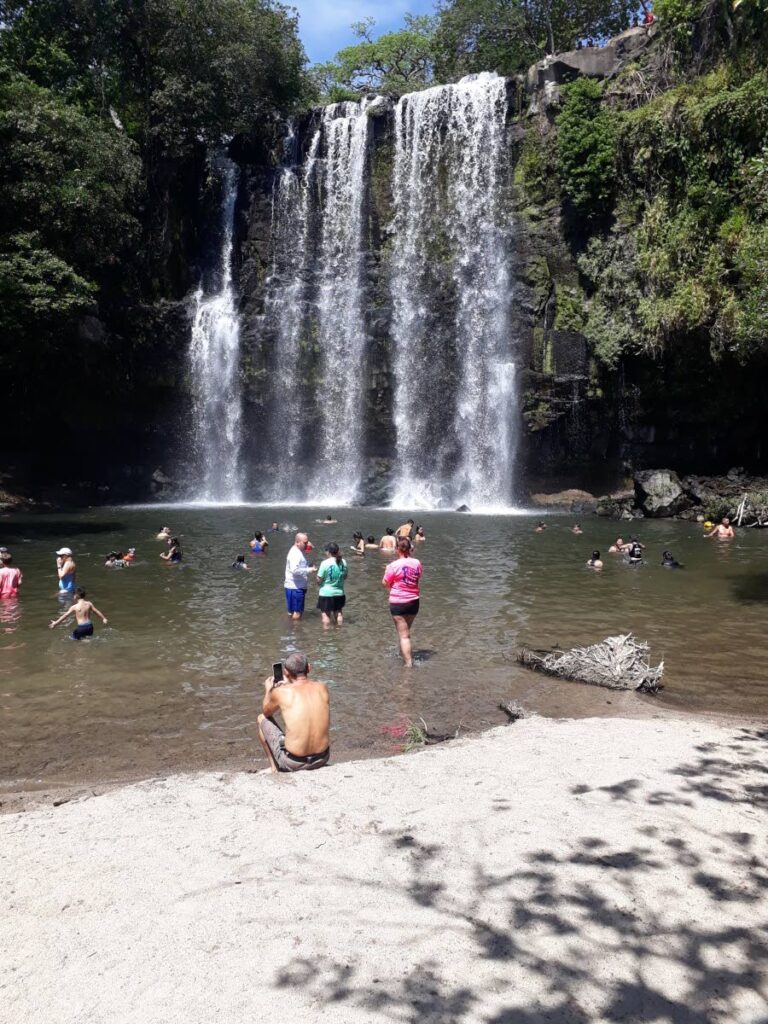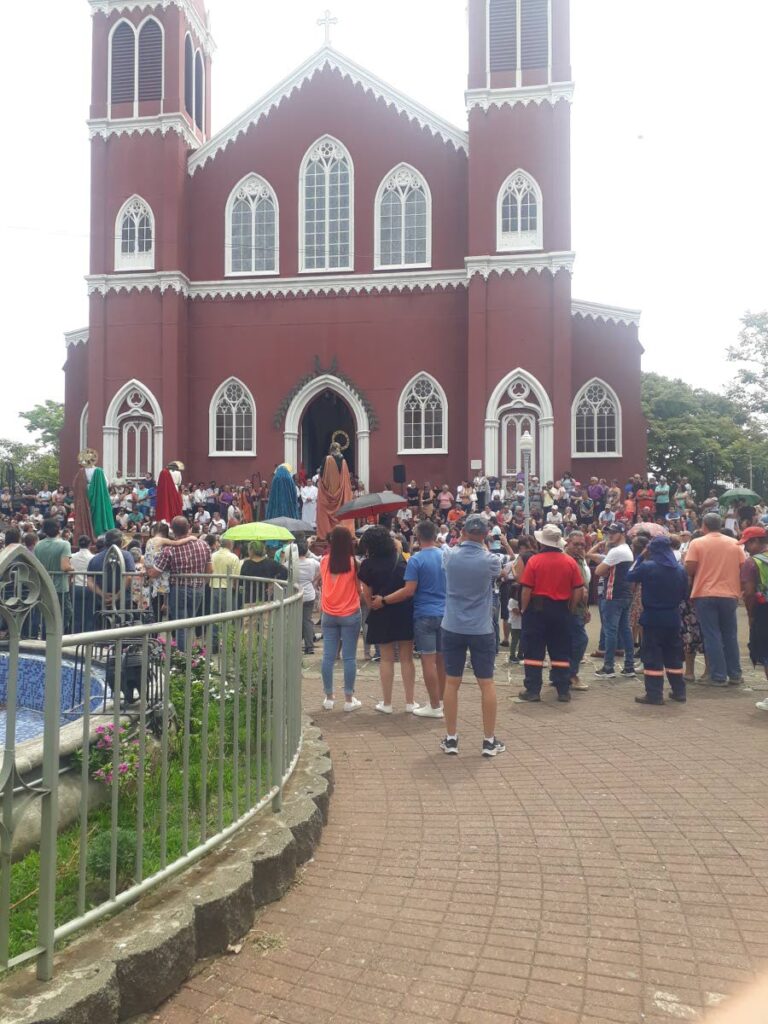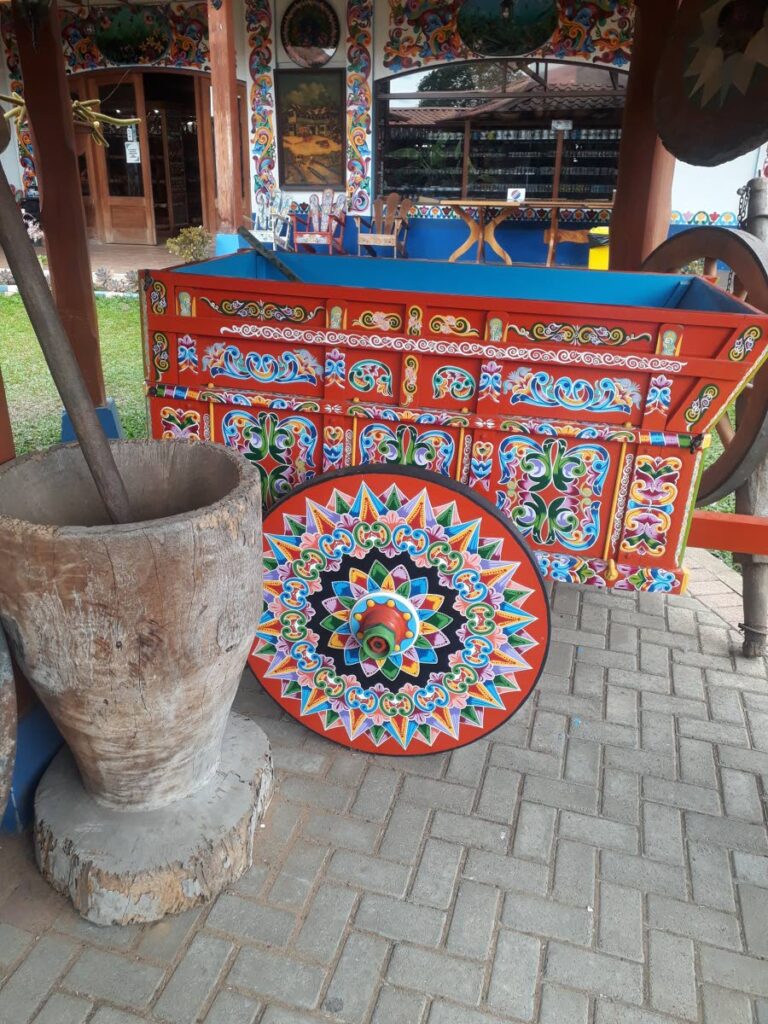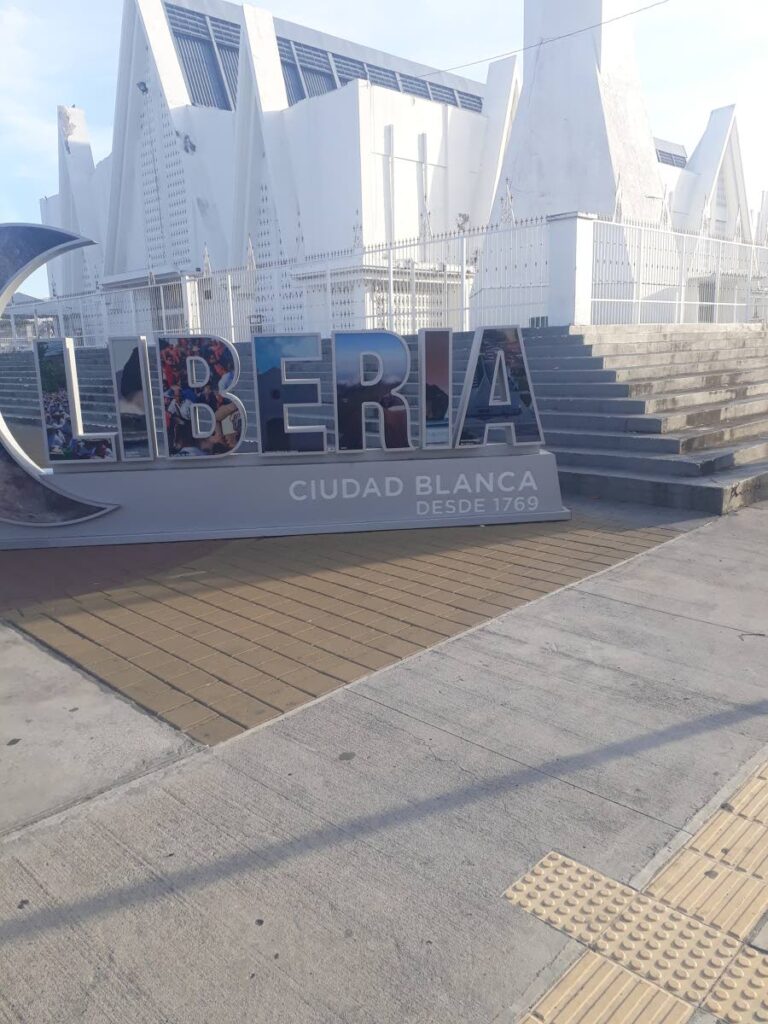Soaking up the last of Costa Rica

In this final part of his three-part series, Jan Westmaas and his group soak in the last few days of their adventures before bidding farewell to the beauty, culture and traditions of Costa Rica.
If you tell the average Trini that you’ve been to Liberia, chances are he or she will think you are talking about a country in the continent of Africa. It’s unlikely that they will think you are referring to a small town in the north-west of Costa Rica. Ironically, this town is popularly known as La Ciudad Blanca (White City). This has nothing to do with race or ethnicity but with the fact that many of the houses and buildings are white-washed, Spanish-colonial style. Apart from that, the white gravel which is plentiful in the area was used to pave the streets in a bygone age.
On Viernes Santo (Good Friday) at around 9 am we set off for that town. It turned out to be a circuitous journey through the valley of the Central Cordillera as we headed for the north-west of the country. This was the route we were taking to get to Quepos, a small seaside town on the Pacific side of the country. It’s located in the province of Puntarenas and is within easy reach of much-talked about Manuel Antonio National Park.
To get to this world-renowned nature reserve, you can use a more direct route from San Jose that takes a mere two and a half hours. This route passes through the bustling, surfing town of Jaco where many North Americans come to retire. On the other hand, if you really want to get around and know the country, you can take the more roundabout route mentioned above, as we did.
By some coincidence as I write, my attention is drawn to an article from the Tico Times shared on my phone by Ronnie, one of our travellers who set up a WhatsApp group for the travellers on tour. I have learnt that two days before we left for home, Volcan Rincon de La Vieja, located 23 kilometres from Liberia where we had spent two nights, had erupted. The report further stated that a gas and steam plume rose two kilometres and five hours prior to the eruption, there was series of earthquakes.
All travellers, surfers included, bring much-needed income to the country. Many foreigners are here to observe how a relatively tiny, tropical country of slightly more than five million inhabitants was able to curtail and, at the same time, to reverse deforestation. What is remarkable is that Costa Rica has 29 national parks that protect the most exotic fauna and flora you can think of. This places it at number 43 in the 2021 list of countries with the largest percentage of protected areas of total land area (28.42 per cent).

Interestingly, Venezuela is third on the list with 56.88 per cent of its territory under protection. TT is listed at number 32, with 30.59 per cent of its land area under protection.
On Good Friday, after leaving San Jose we passed through Alajuela, Costa Rica’s second city, with its central square marked by an inordinate number of mango trees. I spared a thought for Trinidad and Tobago’s national football captain Aubrey David as we made our way through the town. His is a household name among football fans here where he once played professionally for local team, Club Alajuense.
En route to Sarchi, where a stop at its famous craft market was scheduled, we diverted from the Inter-American highway (the Inter Americana) to the charming medium-sized town of Grecia that sits precariously on the slope of the Poas volcano which we were booked to visit on the day before leaving Costa Rica for home (April 14).

“What synchronicity!” my mystical big brother would say. We arrived at the main square just in time to witness the Good Friday procession. To a man, political incorrectness notwithstanding, we poured out of the bus and rushed to the main square (Parque Francisco Alvarado) which faced La Iglesia Nuestra Señora de Mercedes (Church Our Lady of Mercy). The bright, shockingly red exterior of the church made from metal sheets imported from Belgium in the 19th century, aroused our curiosity.
In the meantime, the priest had been on the pavement with his microphone, solemnly intoning the Passion of Christ as the faithful made their way slowly to the front of the church.
Next stop on our schedule was Sarchi, the birthplace of the Costa Rican craft industry. We spent the better part of an hour in Sarchi. The tradition of painting and decorating oxcarts had started here in the early 20th century. Coffee dominated the Costa Rican economy at the time and wooden carretas (carts) pulled by two oxen were the main method of transporting granos de oro (golden coffee grains) to market. Each region had its own oxcart design. In fact, you could identify a driver’s origin by the painted patterns on the wooden wheels of the carreta. At the Eloy Alfaro Oxcart factory, a young man was eager to show us the complicated process involved in making the huge wooden wheels of the oxcart. We were impressed, none more so than Cecil, a semi-retired Civil Engineer in his 80s and an active wood worker himself.

In 2005, UNESCO inscribed Costa Rica’s tradition of vibrantly painted ox carts on its list of culture that contributes to the common heritage of mankind. A year later the world’s largest oxcart was built. Needless to say, Sarchi got itself into the Guinness Book of World Records. Built to scale, it is according to the Tico Times, 14 metres long and weighs two tons.
We boarded the bus to continue our journey to Liberia. Just when our stomachs started to grumble, we stopped for lunch in San Ramon, a small town on the northern side of the Central Valley. By 2 pm we were back on the road hoping to reach Hotel Boyeros in Liberia by 5 pm. As we left the Central Valley and entered the province of Guanacaste, grasslands with cattle sheltering under the shade of the Costa Rican national tree, Guanacaste tree dominated the landscape. The name Guanacaste comes from Guanacastl which in Nahuatl, the Aztec language, means ear tree because the tree’s huge seed pods resemble a human ear.
As we drove past the outskirts of Canas, a small town near Liberia, my eyes fell on a sign Rescate de Pumas (Puma Rescue). This centre is just one of a number of centres set up privately to care for injured or orphaned wildlife. I recalled that pre-pandemic, my daughter Nadia had taken a group of Trinis to visit this particular sanctuary. They had gone to observe how injured or orphaned pumas were taken in and cared for before being released into their natural environment.
In 2013, in keeping with its policy of respect for wildlife, the government of Laura Chinchilla, Costa Rica’s first female president, decided to close the country’s last two remaining zoos (Santa Ana and Simon Bolivar) and move animals either to rescue centres or put them back into the wild. The government shelved these plans because they coincided with new legislation banning private citizens from keeping exotic animals as pets. This resulted in a flood of requests from exotic pet owners to have their pets relocated to the rescue centres. With these centres unable to cope, he government delayed implementation of the planned closures of the zoos. The latest position is that by 2024 the zoos will be shut down.
We got to Liberia at 5 pm as we had hoped. It is noteworthy that Guanacaste, bordering Nicaragua to the north, is the only one of Costa Rica’s seven provinces in which its capital does not have the same name as the province to which it belongs. History also records that in 1824 Guanacaste seceded from Nicaragua and became formally annexed to Costa Rica. The Nicas, as Nicaraguan immigrants are affectionately referred to, constitute officially about seven per cent of the population of Costa Rica. A further 200,000 are undocumented but all told, they appear welcome in the country. Their contribution to the economy in construction, agriculture and domestic services is widely acknowledged.
On the morning of Domingo de resurrecion (Easter Sunday) we ventured half an hour out of town to the Llanos de Cortes waterfall and pool. It was an easy 25-minute drive by bus to the visitorsˊparking lot. From there we undertook a four-minute partly downhill walk on concrete steps with rails on both sides. Then, pardon my French, voilà, we came dramatically face to face with volumes of water gushing down a wide, rocky vertical slope into the spacious but shallow pool beneath.
The majority of the group either dipped and splashed around in the refreshingly cool water or sunbathed on the sand banks of the pool. Meanwhile, a few of us were enticed by a guide to hike to the the top of the falls. Once on top, we were led to La Poza Escondida (the hidden pool), smaller in area than the one below but deeper and darker. Having it virtually to ourselves, I wasted no time diving in and swimming for a few minutes.
Later that evening, a local lottery vendor in his clipped, rapid fire Spanish peculiar to Guanacaste, so heavily influenced linguistically by Nicaragua, had me bemused. I had engaged him to show us around the small town in our bus. I had some difficulty interpreting what he was saying. He led us to the city museum which was once a notorious prison. It was Easter Sunday and the museum was closed but he managed to convince the guard to let us in to see what the prison cells in his humble town looked like. An eager beaver, if anything, our lottery vendor took delight in explaining to us the cruelty that once took place there.
On the bus I took the opportunity to get his opinion on Costa Rica’s President Rodrigo Alberto de Jesus Chaves Robles. He is the country’s 49th president and was Minister of Finance in the previous government under president Carlos Alvarado Quesada. Our feisty lottery vendor expressed his support openly for Robles. “Buen jefe. Le apoyo, ” he said, with a broad smile.
In 2022, Robles defeated ex- President Jose Maria Figueres in a run-off vote, despite revelations or allegations made on the hustings about sexual harassment of employees who worked under him during his tenure at the World Bank as an economist. One political observer noted that Robles has “a liberal economic position, is socially conservative, pro- law and order and against the political class.”
The following morning we said goodbye to Liberia and left for the small town of Quepos where we were booked to stay at Serenity Hotel for some days. Quepos is located in the province of Puntarenas, Costa Rica’s largest province. Puntarenas is also referred to as the Pacific Pearl. It is a small, compact and busy tourist town with an easily accessible lively, lengthy, well-lit promenade. With the variety of restaurants within easy reach and its proximity to the Manuel Antonio National Park – the second most visited park in the country, Hotel Serenity, an elegant but simple hotel, proved to be the ideal place in Quepos to stay while we were on the Pacific.
With stops included, the journey to Quepos which involved some retracing of our steps, lasted more than half-day. We enjoyed two memorable stops en route. The first was in Orotina, where we stopped for lunch at a buffet-style restaurant. We were greeted by a two-member marimba band playing musica bailable (dance music). Finding the music irresistible, I started dancing at once. Spontaneously other members of our party joined me.
The second memorable stop on our journey to Quepos was at the Taracoles River, not far from the restaurant. High up on the bridge spanning the river, we were able to have a bird’s eye view of huge crocodiles basking on the sunny, sandy river bank. After this interlude, we boarded the bus for the last leg of our journey which took us just an hour. On the way across the Gulf of Nicoya, we caught sight of the Nicoya Peninsula, one of the world’s five “blue zones” or areas where people live the longest lives. What about life on the Nicoya Peninsula was responsible for this? Gina Lisa, asked rather pensively.
On April 12, at 8 am, we arrived at the entrance of Manuel Antonio Park for our scheduled visit. The smallest of the country’s national parks, it is estimated that it hosts 346 plant species which provide food and shelter for 350 species of birds and 100 species of animals. The place was brimming with tourists and guides preparing to enter. The highlight of our forest walk was the close up views we had of sloths and monkeys sitting on branches of trees hanging just above our heads. The following day we returned to the centrally-located Hotel Presidente in San Jose. We left for home on April 14. Costa Rica 2023, rich in geography, history, culture, biodiversity, a thriving democracy with a population welcoming to foreigners of all colours, shapes and sizes, will remain deeply imprinted in our minds. That to my mind is what Pura Vida is all about.


Comments
"Soaking up the last of Costa Rica"